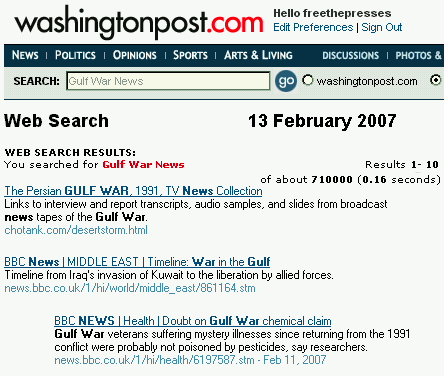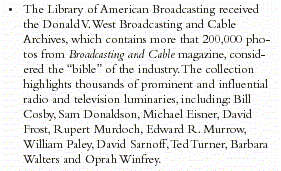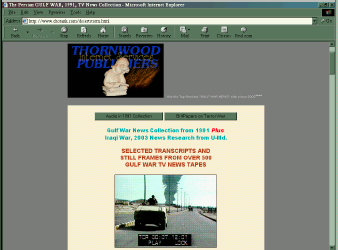 Douglas Gomery Compares U-Md Library to Newseum, open in DC
Douglas Gomery Compares U-Md Library to Newseum, open in DC
|
article about Footes' War TV News Collection at U-Md, College Park, 26 November 2001 Home > Gulf War News Collection > Archives II at College Park > Where You Are! New Tools Showed Gulf War on TV By Frazier Moore AP Television Writer Sunday, Jan. 14, 2001; 1:14 p.m. EST A decade ago, TV's coverage of Operation Desert Storm rallied a newsgathering effort whose responsiveness was unknown during Vietnam, the oft-described "living room war" of a quarter-century earlier. This was a new kind of war coverage that, thanks to satellite technology, delivered images of fighting as it happened. "Instead of in the living rooms," recalls CNN veteran Bernard Shaw, "it was in people's faces." And there were many faces to be seen. Besides the soldiers from home, there were grinning Saudis and Kuwaitis who flashed the V-sign as they rolled past the cameras. There were Iraqi soldiers, wearing naked expressions of relief upon surrender or capture by allied forces once the ground war began. But the high-tech marvels clashed with political agendas. Censors kept journalists away from much of the action, and didn't hesitate to pull the plug on correspondents' gadgetry if it fed an inconvenient message to the world. With on-site video limited, and its broadcast often delayed, TV had to find other ways to explain what was happening. Every available military analyst was drafted for duty, and maps, charts and diagrams were used extensively. ABC's Peter Jennings even took viewers for a walk through the Gulf region, striding across a huge map on the floor of his Manhattan studio. "The way you control war coverage is to control the movement of reporters and camera crews," says Shaw, "and all sides did that very effectively – especially the Pentagon." Despite its long tradition of a free press, the U.S. government came under fire from reporters, who complained that the media pool system for covering combat was designed less for efficiency than for managing the news. Saudi censors, reacting to live TV pictures of nighttime Iraqi missile attacks, warned the networks not to report exact locations of missile strikes. Israeli officials, concerned that live TV shots of missile strikes could help Iraqis adjust their fire, issued similar cautions. Early on, ABC scored with video showing a barrage of Iraqi anti-aircraft fire over Baghdad. Shot with a night-vision device that painted the city in a luminous green, the pictures showed tracer bullets that looked like streams of deadly pearls streaking into the pre-dawn sky. But those pictures couldn't be aired live. The footage was transported to Jordan for transmission hours later. CNN got perhaps the most riveting scoop of the whole war with what, in effect, was a live radio dispatch. Blessed with an audio link in their ninth-floor Baghdad hotel room, Shaw and colleagues Peter Arnett and John Holliman gave voice accounts of explosions and anti-aircraft fire during the first U.S. air strikes. "I'm lying on the floor," Shaw said during one eerie pause. "The sky over Baghdad is black. ... It occurs to me that I didn't get dinner tonight." By next morning, Iraqi military authorities had ordered the reporters to cease those broadcasts. Such coverage didn't go unnoticed at home, either. Assessing bomb damage during a news conference, Powell, chairman of the Joint Chiefs of Staff, added the joking disclaimer, "at least according to what Bernie Shaw tells me." TV was an information resource at the White House, too. President Bush watched the televised briefings given in Saudi Arabia by Schwarzkopf, his commander of U.S. forces in the region. But Ken Bode notes that, through it all, there prevailed a mutual distrust between the press and the military. "It was left over from the Vietnam War," says Bode, formerly a network correspondent and host of PBS' "Washington Week in Review" and now dean of Northwestern University's Medill School of Journalism. "The press took into the Persian Gulf War the idea that the government will lie to the American people," he says. "The military assumed that the press is a disloyal and unreliable force, and therefore tried to keep us at arm's length." Still, Bode voices hopes for eventual detente. Shaw isn't such an optimist, despite subsequent conferences between the press and the Pentagon on finding ways to bury the hatchet in wartime. "They all say, 'Well, let's do it different and better next time,'" declares Shaw. "But it'll never happen. We'll always be in contention." © Copyright 2001 The Associated Press Another article by Frazier Moore from AP on War News in Iraq
This Associated Press article appeared originally as a Chotank.com link to The Washington Post which had been added to the main Gulf War TV Collection page on January 14, 2001 at 3:20 pm EST. Because The Washington Post deleted AP stories from its server after 14 days the external link became invalid on January 28, 2001.  After receiving several student requests, the article was restored from the Chotank cache only for fair use, educational purposes to better understand the Gulf War and causes of the September 11, 2001 attacks on World Trade Center. Since 2002 and until 4 July 2010, Chotank.com has ranked consistently number one at The Washington Post when requesting a GOOGLE or YAHOO web search for "War TV News", "Gulf War News" or "Gulf War TV". The article and related web material have been required readings in the Communication Senior Seminar (Com 450) classes when taught by Avon Edward Foote at the University of North Alabama. The course in fall 2005 to 2007 focused on the history of cable with its recent expansion into telephone and broadband internet services. A blog article, developed especially for Foote's course, is about Frank Kyle Spain and his role in the corporate start-up of Comcast Cable in Tupelo, Mississippi. The article, that includes information on Pentagon decisions which later helped Worldcom, Comcast, and CNN, After receiving several student requests, the article was restored from the Chotank cache only for fair use, educational purposes to better understand the Gulf War and causes of the September 11, 2001 attacks on World Trade Center. Since 2002 and until 4 July 2010, Chotank.com has ranked consistently number one at The Washington Post when requesting a GOOGLE or YAHOO web search for "War TV News", "Gulf War News" or "Gulf War TV". The article and related web material have been required readings in the Communication Senior Seminar (Com 450) classes when taught by Avon Edward Foote at the University of North Alabama. The course in fall 2005 to 2007 focused on the history of cable with its recent expansion into telephone and broadband internet services. A blog article, developed especially for Foote's course, is about Frank Kyle Spain and his role in the corporate start-up of Comcast Cable in Tupelo, Mississippi. The article, that includes information on Pentagon decisions which later helped Worldcom, Comcast, and CNN, may be found at:
http://www.chotank.com/classes/una2.html may be found at:
http://www.chotank.com/classes/una2.html
Frazier Moore graduated from the University of Georgia, Grady College of Journalism and Mass Communications, Athens in 1974 when his father -- also Frazier Moore-- was head of Advertising and Public Relations. Moore is current 2009-2010 Peabody Awards Board Member, Grady College. Eddie Foote remembers Frazier's father from when Foote joined UGA faculty in 1974. He had several friendly talks with the elder Frazier Moore and many other conversations with Dean Drewry of University of Georgia who cofounded the Peabody Awards and shared office complex with Foote, Becky Quarles and Vernon Stone. Foote participated in preliminary screening of entries with current NBC Executive (http://nbcumv.com/corporate/bio_detail.nbc/nbcexecutives-0-alan-wurtzel.html) Alan Wurtzel for the national Peabody Committee that now -- over a quarter century later -- includes young Frazier himself.
WSJ BLOG: "China Stars at the Peabody Awards for Electronic Media" or
Moore serves on the Peabody Board with Harry A. Jessell, former editor of Broadcasting & Cable, who first approved Foote getting over $25,000 of B&C publications. Foote and Jessell arranged the B&C support while seated together with Don and Carroll Virginia West UGA graduate Tom Johnson was head of CNN when Moore wrote the article. In May 2008 Johnson spoke at Atlanta memorial services for Hamilton Jordan, White House chief of staff under President Carter. After Foote chatted with Johnson in Washington hotel hallway in 1977, former Secretary of Defense Melvin Laird introduced Foote to Admiral Zumwalt in the lobby of the Ritz-Carlton, a few blocks from the White House. At the time, the Army had started distribution of an article on psychological operations by Dr. Foote in a special two-volume book set on Psy-op. According to the Online Computer Library Center's WorldCat, the book set is available in 261 libraries in June 2008, a list you can get by clicking -- The Art and Science of Psychological Operations: Case Studies of Military Application, (DA PAM 525-7-1; 525-7-2), Washington: 1976. And, Johnson was publisher of Los Angeles Times, not moving to CNN until 1991.
Avon Edward Foote
|

 at the Broadcasting & Cable table honoring
at the Broadcasting & Cable table honoring 
